According to the State of Michigan, the total number of COVID cases in Michigan rose to 53,009 on May 20, an increase of 659 cases from the previous day. This total was equivalent to 530 cases per 100,000 people (Chart 4). Of those 659 cases 227 were documented in Southeastern Michigan. This means that of the new daily COVID cases Southeastern Michigan accounted for 34 percent of them, highlighting how now most of the new cases are occurring outside of the region. The five-day rolling average for the total number of COVID cases (Chart 1) reflects a smoother curve and adjusts for fluctuations in testing and/or the quality of reporting or failure to report. While the curve is smooth, Chart 1 shows that number of cases in Michigan continues to increase, and at higher rates in recent days due to varying factors. The total number of State cases increased by 1.13 percent yesterday, while they only increased by 0.8 percent the day before. Additionally, in Detroit cases increased by 0.8 percent and in Wayne County they increased by 0. 7percent on May 20, further showing that the overall number of cases in the state is growing faster than those regionally.
Chart 2 shows that, based on the five-day rolling averages, the growth of new COVID cases in Southeastern Michigan has begun to level off for the counties in region. The flattening of the COVID growth curves in Southeastern Michigan also further supports how the increase of COVID cases is slowing in the region, despite the State experiencing a higher growth rate. On May 18 the number of cases in Detroit reached 10,392, the highest in the region, and Wayne County reported the second highest number of cases at 8,795. On May 18, the five-day rolling average for the number of COVID cases in Oakland County was 8,062, and Macomb County reported 6,353.
The City of Detroit had 1,561 COVID cases per 100,000 people on May 20, an increase from 1,549 the day before (Chart 3). This is based upon a reported increase of 82 new COVID cases, bringing the total number of COVID cases in Detroit to 10,499. Wayne County reported 830 cases per 100,000 people, and Oakland County had 645 cases per 100,000 people. These per capita rates were based upon 8,933 total cases for Wayne and 8,117 for Oakland. Macomb County reported 731 cases per 100,000 people, which is based upon 6,392 cases. While the increase in daily case numbers has slowed in Southeastern Michigan overall, the number of new COVID cases in the region on May 20 was the highest it has been in about a week.
The daily data highlighted in these posts is from Michigan.gov/coronavirus, where data is updated daily at 3 p.m. Historical data were supplied from covidtracking.com, which republishes COVID data from the State. Additionally, the case totals do not reflect the number of people who have recovered, just those who have been infected.
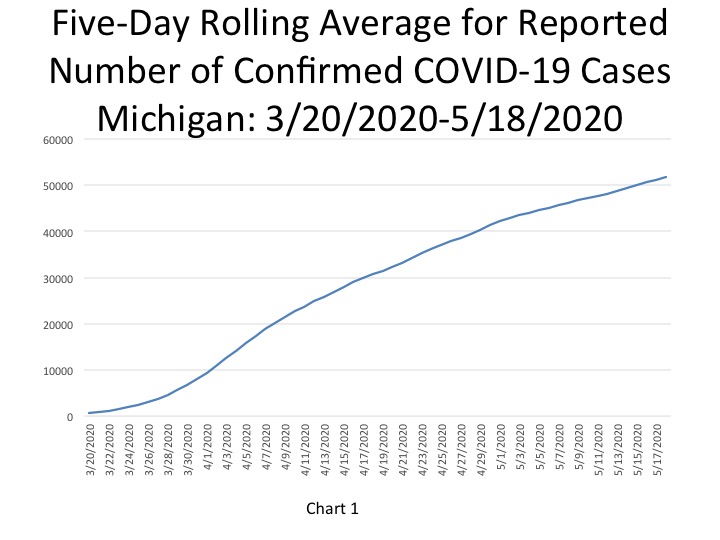
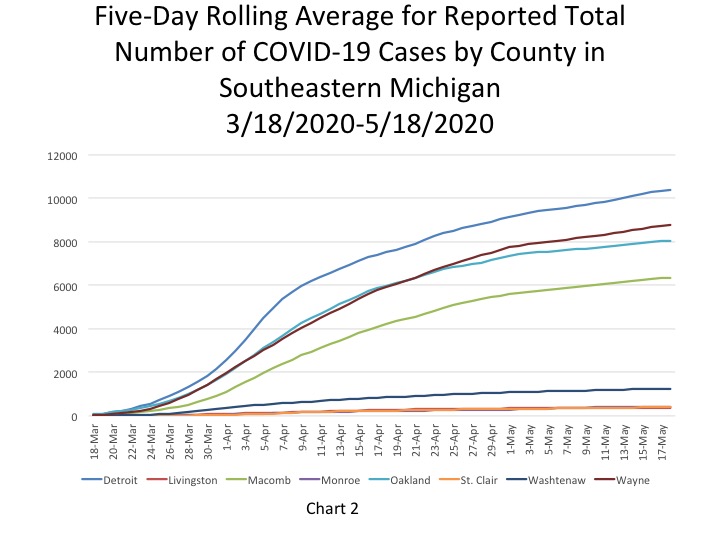
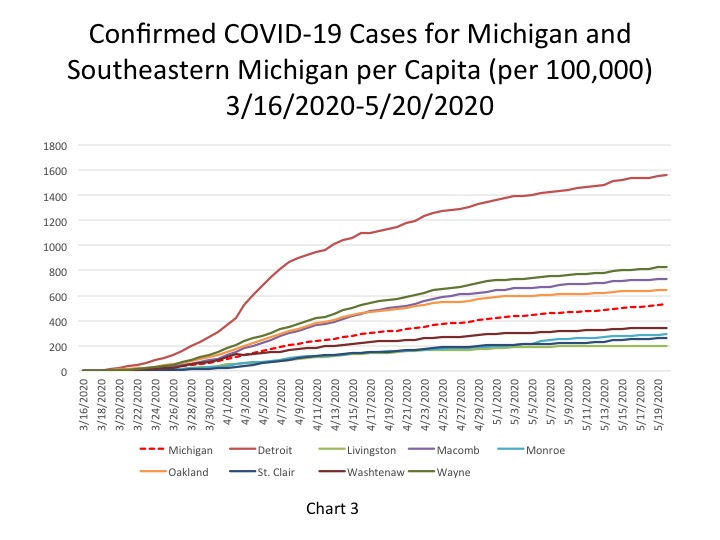
Chart 4 shows that Wayne County reported the highest number of daily cases at 56 on May 18, a small increase from the day prior when it also had the highest number of daily cases. Overall, this chart shows that daily case numbers throughout Southeastern Michigan continues to decline, despite State numbers experiencing spikes in recent days, including yesterday.
On May 20 the per capita rate for the number of new daily COVID cases per 100,000 people was 6.6 for the State; this was equivalent to 659 new cases. The number of new cases the State reported on May 20 was an increase of an additional 224 COVID cases from the day before. Detroit was the only government entity in the region to report a higher per capita rate for the number of new daily COVID cases per 100,000 people than the State. On May 20 Detroit reported a per capita rate of 12 new COVID cases per 100,000 people, which was equivalent to 82 new cases. Wayne County reported 5 new COVID cases per 100,000, which was equivalent to 58 new cases. Oakland County reported a per capita rate of 3 new case per 100,000 people on May 20, which was equivalent to 39 new cases, and Macomb County reported a rate of 3, which was also equivalent to 25 new cases. Overall, 227 new COVID cases were reported in Southeastern Michigan on May 20. This is an increase in the total number of daily COVID cases in Southeastern Michigan from the day prior, but still shows that majority of the new COVID cases are being reported outside of the region. Wayne County (including Detroit data) saw the largest increase in cases Wednesday (140), followed by Kent County (102), and Ottawa County (40).
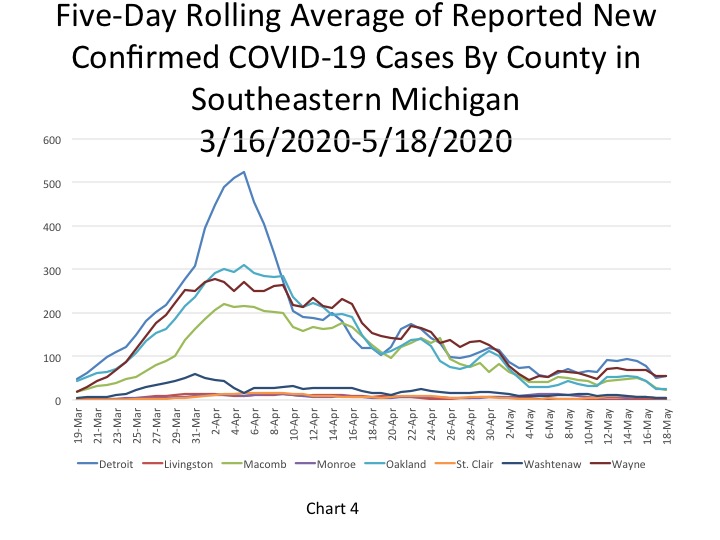
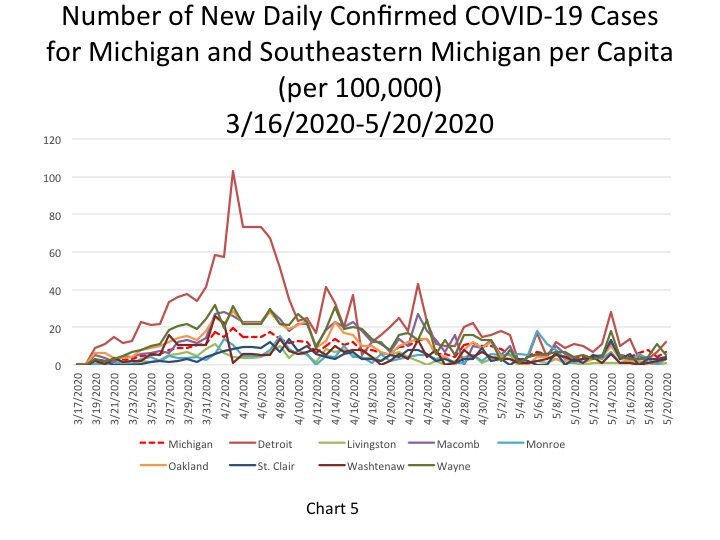
In Chart 6, the five-day rolling average for the number of deaths in Michigan shows a continuing slow increase (a lagged number of 4,952 deaths, an increase of 47 deaths). The actual reported COVID-19 on May 20 was 5,060, an increase of 43 deaths from the day prior. Of those 43 additional deaths Southeastern Michigan accounted for 28 of them.
Chart 7 (a 5-day rolling average) portrays how the total number of COVID deaths in Southeastern Michigan continues to level off, with Detroit reporting the highest cumulative number of deaths at 1,265 on May 18. Wayne County had the second highest total at 977 on May 18.
Chart 8 portrays the total number of COVID deaths per 100,000 people, and the majority of governmental units did not show an increase from the day before. As of May 20, the cumulative total of COVID deaths per 100,000 people in Detroit was 190 (representing 1,280 deaths). In Wayne County there were 93 COVID deaths per 100,000 people (1,004 total deaths), in Oakland County there were 74 deaths per 100,000 people (935 total deaths), and in Macomb County there were 87 COVID deaths per 100,000 people (763 total). The State of Michigan had 51 COVID deaths per 100,000 people, which was equal to 5,060 total deaths. Macomb County had the highest single day death count in Southeastern Michigan on May 20; 20 COVID deaths were reported. Macomb and St. Clair counties were the only two counties in the region to experience a per capita rate increase.
In Chart 9 we see that the number of daily statewide deaths increased slightly to 47 on May 18; it was reported to be 46 the day prior. Chart 10 shows how the number of deaths in Southeastern Michigan, except in Macomb County, have been either leveling off or decreasing. In Macomb County there was a reported 747 deaths, which was an increase of 7 from the day prior. On May 17, 5 COVID deaths were reported in Macomb County. Wayne County though reported the highest number of daily deaths at 10, the same number it reported the day prior. Detroit and Oakland County each reported 8 daily COVID deaths for the fourth day in a row. This truly shows how the number of deaths in Southeastern Michigan are stabilizing at much lower levels than what they were reported at a month ago. On May 18, of the 47 new deaths reported 34 were reported out of Southeastern Michigan. These numbers are based on 5-day rolling averages.
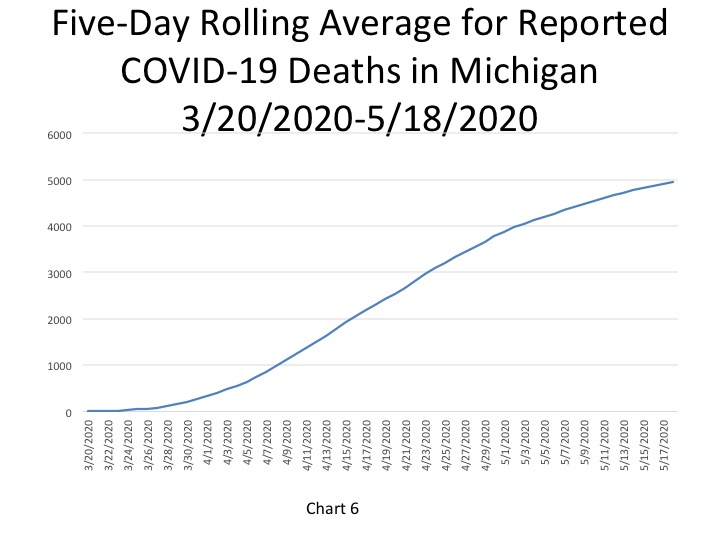
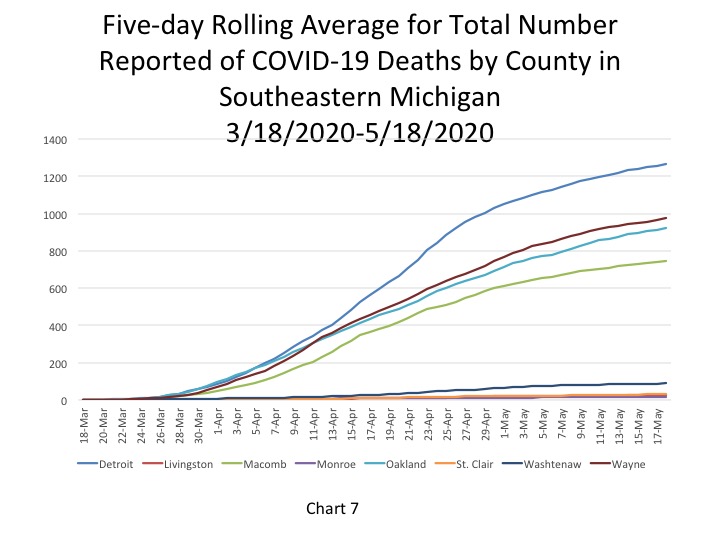
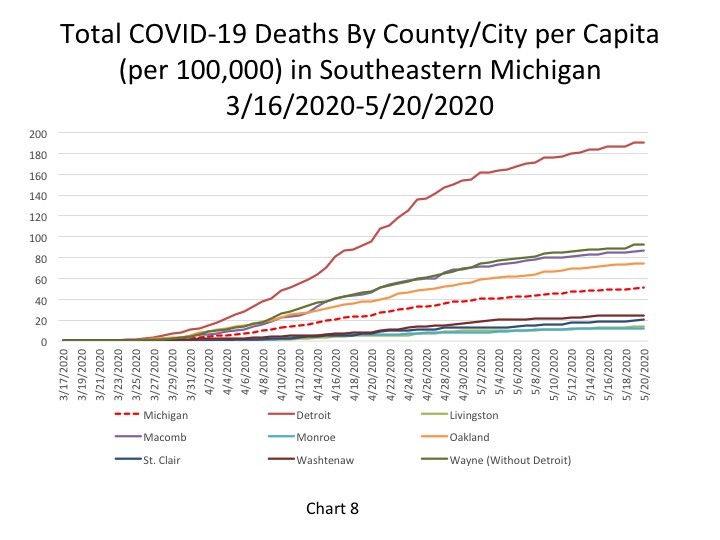
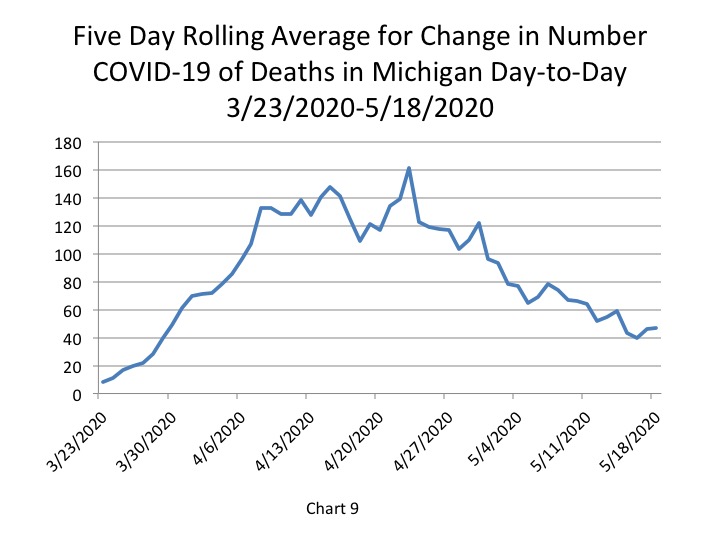
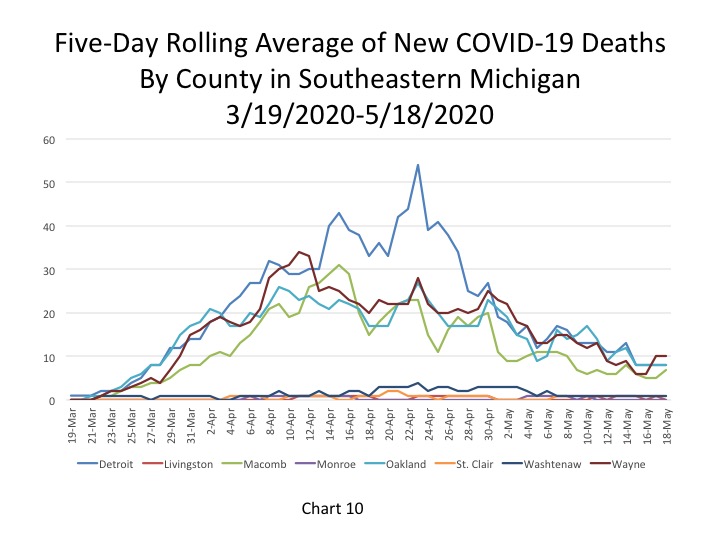
On May 20 Detroit continued to report a fatality rate of 12.2 percent, showing while it is the highest rate in the region it has leveled off. Macomb County has the second highest fatality rate in the region at 11.9 percent, and the State reported a fatality rate of 9.6 percent.
One reason we may be seeing such high fatality rates in Michigan is due to the low testing rates. When only having-presumably-a lower of number confirmed COVID cases than is actually likely due to the limited availability of tests, the fatality rate appears higher because the base comparison is smaller than it might be.
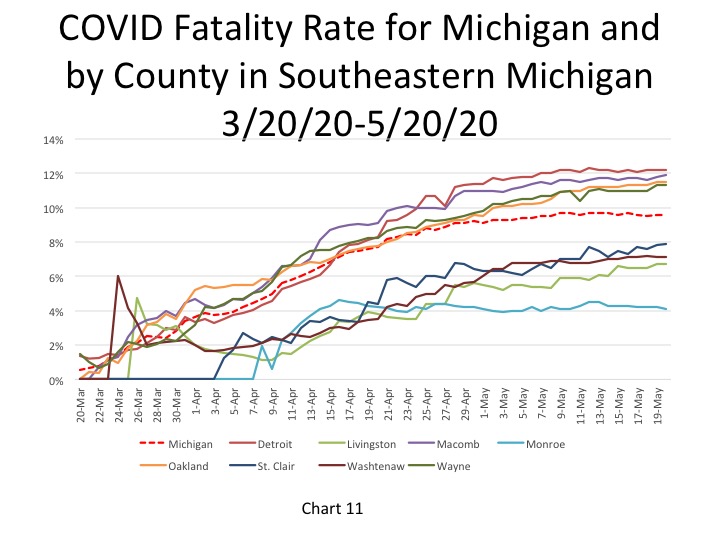
As the daily case and death numbers in Southeastern Michigan decline and begin to stabilize, we must still be aware that case numbers are increasing in other areas of the State. Due to the nature of the virus, this means that a second wave of infection could easily be felt locally. However, in Southeastern Michigan the steps taken to prevent increased spread have been showing signs of working.